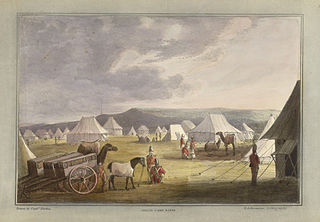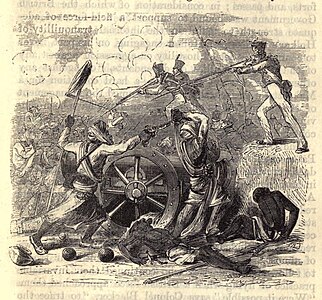
Indore ) is the largest and most populous city in the Indian state of Madhya Pradesh. It is consistently ranked as the cleanest city in India. It serves as the headquarters of both the Indore District and the Indore Division. It is also considered as the state education hub and houses campuses of both the Indian Institute of Technology and the Indian Institute of Management. Located on the southern edge of Malwa Plateau, at an average altitude of 553 meters (1,814 ft) above sea level, it has the highest elevation among major cities of Central India. The city is 190 km (120 mi) west of the state capital of Bhopal. It is 57 km (35 mi) from Ujjain and 35 km (20 mi) from Dewas. Indore had a census-estimated 2011 population of 1,994,397 and 3,570,295. The city is distributed over a land area of just 530 square kilometres (200 sq mi), making Indore the most densely populated major city in the central province.

The Third Anglo-Maratha War (1817–1819) was the final and decisive conflict between the British East India Company and the Maratha Empire in India. The war left the Company in control of most of India. It began with an invasion of Maratha territory by British East India Company troops, and although the British were outnumbered, the Maratha army was decimated. The troops were led by Governor General Hastings, supported by a force under General Thomas Hislop. Operations began against the Pindaris, a band of Muslim mercenaries and Marathas from central India.

Malwa is a historical region of west-central India occupying a plateau of volcanic origin. Geologically, the Malwa Plateau generally refers to the volcanic upland north of the Vindhya Range. Politically and administratively, it is also synonymous with the former state of Madhya Bharat which was later merged with Madhya Pradesh. At present the historical Malwa region includes districts of western Madhya Pradesh and parts of south-eastern Rajasthan. Sometimes the definition of Malwa is extended to include the Nimar region south of the Vindhyas.

Mandsaur is a city and a municipality in Mandsaur district located on the border of Mewar and Malwa regions of Madhya Pradesh, a state in Central India. It is the administrative headquarters of Mandsaur District. The ancient Pashupatinath Temple is located in Mandsaur.

The Holkars were a family that was part of the Maratha Empire, which held the rank of subahdar under Peshwa Baji Rao I. When the Maratha Empire began to weaken due to internal clashes, the Holkars declared themselves the rulers of Indore in Central India, existing as an autonomous member of the Maratha Empire until 1818. Later, their kingdom became a princely state under the protectorate of British India.

Ahilyabai Holkar, also spelled Ahalya Bai, was the Rani of Indore, within the Maratha Confederacy. She established Maheshwar as the seat of the Holkar Dynasty.
Mahidpur City is a city and a municipality, near Ujjain city in Ujjain district in the Indian state of Madhya Pradesh. Mahidpur City takes its name from Raja Jhala Maheda Singh, who was the founder of Mahidpur. The modern town of Mahidpur is situated on the bank of river Shipra. It is located in the Malwa region. At present, the town is a tehsil place of Ujjain district.

Malhar Rao Holkar was a noble subedar of the Maratha Empire, in present-day India. He was one of the early officers along with Ranoji Scindia to help spread the Maratha rule to northern states and was given the estate of Indore to rule by the Peshwas, during the reign of the Maratha emperor Shahu I. He was founder of the Holkar dynasty that ruled Malwa.

Gwalior state was a semi-autonomous Maratha state. It was centred in modern-day Madhya Pradesh, arising due to the rise of the Maratha Empire and fragmentation of the Mughal Empire.

Shrimant Daulat Rao Shinde was the Maharaja (ruler) of Gwalior state in central India from 1794 until his death in 1827. His reign coincided with struggles for supremacy within the Maratha Empire, and wars with the expanding East India Company. Daulatrao played a significant role in the Second and Third Anglo-Maratha wars.

The history of Madhya Pradesh can be divided into three periods - the ancient period, the medieval period and modern period.

Jaora State was a 13 gun-salute princely state of the British Raj. It was part of the Malwa Agency.
Kampel is a panchayat village in the Indore block of the Indore district, Madhya Pradesh, India. It was the headquarters of a pargana in Mughal Empire before the administrative center of the region was shifted to Indore city under the Holkars of the Maratha Empire.

Rao Nandlal Chaudhary was the chief of the Zamindars of Kampel, near Indore. He was a Gaur Brahmin. Under the suzerainty of the Mughals, he controlled Kampel and some of its surrounding area including Indore. He accepted the suzerainty of the Marathas, after the Nizam acceded to the Peshwa's demands in 1724.

Tukoji Rao Holkar, belonging to the Holkar clan of the Marathas was the feudatory of Indore. Tukoji Holkar was the adopted son of Malhar Rao Holkar, he was the second son of Shrimant Tanuji Holkar, a nephew of Malhar Rao Holkar. Thus he was also the grand-nephew of Malhar Rao Holkar. He married two wives. He had four sons Kashi Rao, Malhar Rao II Holkar, Yashwant Rao, and Vithoji Rao.

Indore State, also known as Holkar State, was a kingdom in India. Its rulers belonged to the Maratha Holkar dynasty. After 1857, Indore became a 19-gun salute princely state under the British Raj.
Maharani Tulsi Bai Holkar was a queen of Indore by marriage to Maharaja Yashwant Rao Holkar, and regent of the Indore State for her Malhar Rao Holkar II between November 1811 – 20 December 1817.
Bhima Bai Holkar, was a daughter of Yashwant Rao Holkar, Maharaja of Indore. She was the grand-daughter of queen Ahilya Bai Holkar and the elder sister of Malhar Rao Holkar III.
Khanderao Holkar was the only son of Malhar Rao Holkar, the founder of the Holkar dynasty of Indore, and Gautama Bai. He was the husband of Ahilyabai Holkar. He served as a Maratha Sardar and fought several campaigns on behest of the Maratha empire.

The Krishnapura Chhatris, also known as the Krishna Pura Chhatris are three chhatris located in Indore, Madhya Pradesh, India. The structures were built by the Holkars as cenotaphs over the spots where people of importance were cremated, leading to them also being known as the Holkar Chhatris. All three of the Chhatris are located half a kilometer from the city palace, Rajwada, which was also built by the Holkar dynasty.

















